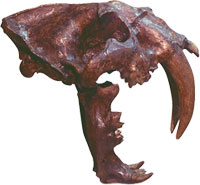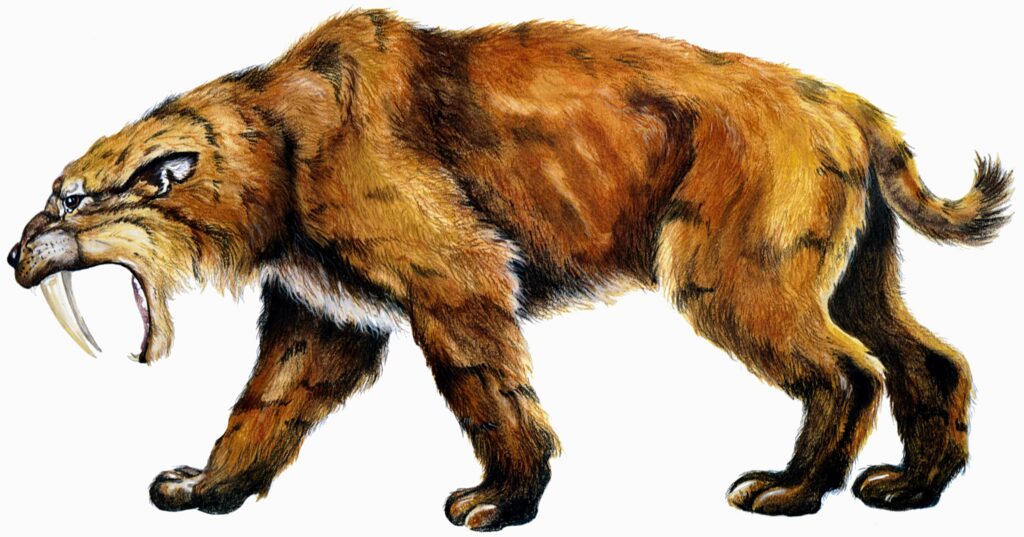sabre-toothed cat, any of the extinct catlike carnivores belonging to either the extinct family Nimravidae or the subfamily Machairodontinae of the cat family (Felidae). Named for the pair of elongated bladelike canine teeth in their upper jaw, they are often called sabre-toothed tigers or sabre-toothed lions, although the modern lion and tiger are true cats of the subfamily Felinae.
Sabre-toothed cats existed from the Eocene through the Pleistocene Epoch (56 million to 11,700 years ago). According to the fossil record, the Nimravidae were extant from about 37 million to 7 million years ago. Only distantly related to felids, they include the genera Hoplophoneus, Nimravus, Dinictis, and Barbourofelis. The Machairodontinae, extant from about 12 million to less than 10,000 years ago, include the more familiar Smilodon as well as Homotherium and Meganteron. Sabre-toothed cats roamed North America and Europe throughout the Miocene and Pliocene epochs (23 million to 2.6 million years ago). By Pliocene times, they had spread to Asia and Africa. During the Pleistocene, sabre-toothed cats were also present in South America.
The most widely known genus of sabre-toothed cats is Smilodon, the “sabre-toothed tiger.” A large, short-limbed cat that lived in North and South America during the Pleistocene Epoch, it was about the size of the modern African lion (Panthera leo) and represents the peak of sabre-tooth evolution. Its immense upper canine teeth, up to 20 cm (8 inches) long, were probably used for stabbing and slashing attacks, possibly on large herbivores such as the mastodon. Several physical adaptations of Smilodon suggest such a hunting technique: its skull was modified to accommodate the attachment of strong neck muscles for bringing the head down; the lower canines were reduced; sabre-toothed cat and the molars formed shearing blades with no trace of grinding surfaces. In addition, the jaw could be opened to about a 90° angle to free the upper canines for action; however, some paleontologists suggest that since the muscles in the jaw would have had to stretch significantly to enable such a wide gape, they would have been relatively weak compared with those of modern cats. The bones of many Smilodon specimens have been recovered from the La Brea Tar Pits in Los Angeles, California; the cats were apparently mired in the tar as they preyed on other animals that had also become trapped.
WHAT IS A sabre-toothed cat
When sabre-toothed cat you think of saber-toothed predators, those huge, scary cats with long, sharp teeth probably come to mind. But did you know there wasn’t just one kind of saber-toothed cat? This cool “saber-tooth” look actually evolved multiple times in different groups of mammals! Saber teeth showed up in different animal families at different times, kind of like nature experimenting with the same idea more than once. For example, true cats—like lions and tigers—had their own saber-toothed relatives called Machairodontinae. But there were also saber-toothed animals in another family called Nimravidae, which were related to cats but also connected to animals like civets and mongooses. On top of that, a completely different group called Hyaenodontidae, which belonged to an extinct order known as Creodonta, had saber-toothed members too. And if that’s not wild enough, even some saber-toothed marsupials lived in South America millions of years ago! This is a great example of something called convergent evolution—basically, when different animals evolve similar features independently because those features help them survive in similar ways. So, saber teeth weren’t just a one-time thing, but a successful “design” that popped up again and again in different species.

Saber-toothed cats are some of the coolest and most famous Ice Age animals in North America, especially known for their long, dagger-like teeth that stuck out from the sides of their mouths. When most people think of them, they picture the “saber-toothed tiger,” but actually, there were many different types of saber-toothed cats that lived over the last 40 million years! Interestingly, today’s big cats don’t have those iconic saber teeth, which makes the past world pretty unique since saber-tooths were once common members of many animal communities. The last group of saber-toothed cats are called machairodonts, and their fossils have been found in eastern North America. In Indiana, the only saber-tooth found so far is the famous Smilodon fatalis, the “true” saber-tooth. But just a little ways away—in northeastern Arkansas and central Tennessee—scientists have found fossils of its relative, the Scimitar cat, known as Homotherium serum. That means these cats probably lived around Indiana too!

